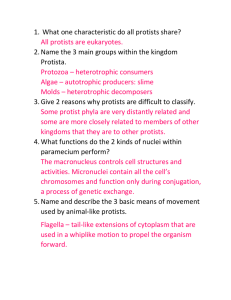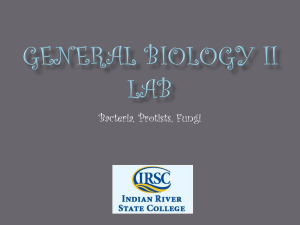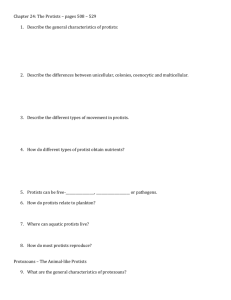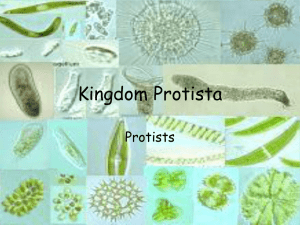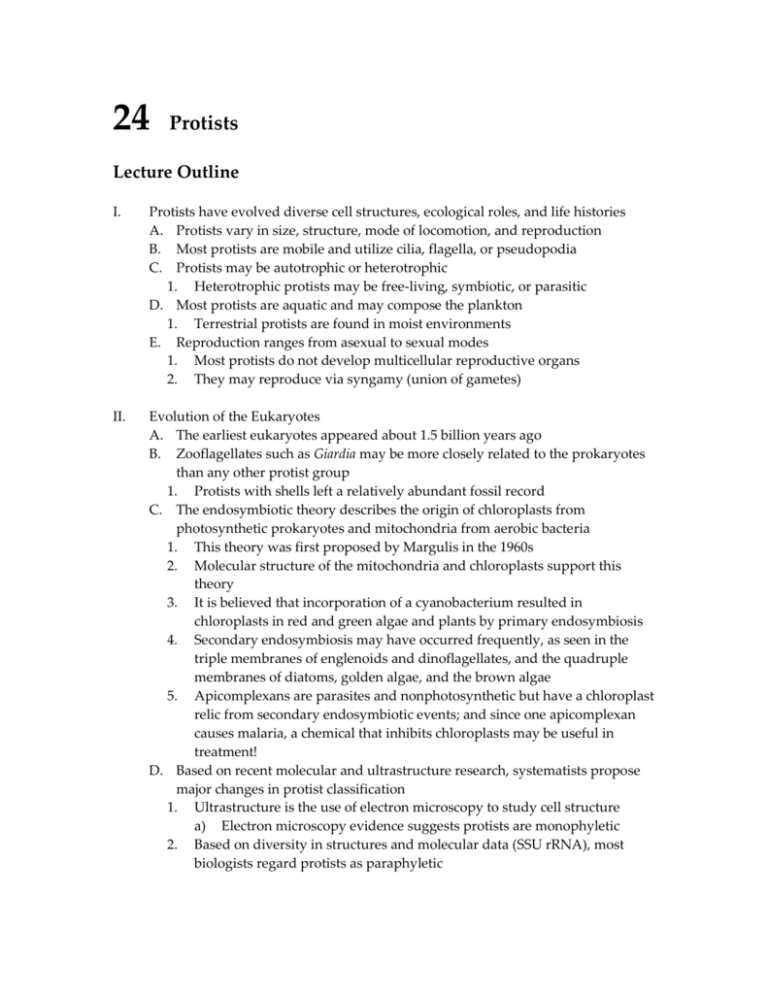
24
Protists
Lecture Outline
I.
Protists have evolved diverse cell structures, ecological roles, and life histories
A. Protists vary in size, structure, mode of locomotion, and reproduction
B. Most protists are mobile and utilize cilia, flagella, or pseudopodia
C. Protists may be autotrophic or heterotrophic
1. Heterotrophic protists may be free-living, symbiotic, or parasitic
D. Most protists are aquatic and may compose the plankton
1. Terrestrial protists are found in moist environments
E. Reproduction ranges from asexual to sexual modes
1. Most protists do not develop multicellular reproductive organs
2. They may reproduce via syngamy (union of gametes)
II.
Evolution of the Eukaryotes
A. The earliest eukaryotes appeared about 1.5 billion years ago
B. Zooflagellates such as Giardia may be more closely related to the prokaryotes
than any other protist group
1. Protists with shells left a relatively abundant fossil record
C. The endosymbiotic theory describes the origin of chloroplasts from
photosynthetic prokaryotes and mitochondria from aerobic bacteria
1. This theory was first proposed by Margulis in the 1960s
2. Molecular structure of the mitochondria and chloroplasts support this
theory
3. It is believed that incorporation of a cyanobacterium resulted in
chloroplasts in red and green algae and plants by primary endosymbiosis
4. Secondary endosymbiosis may have occurred frequently, as seen in the
triple membranes of englenoids and dinoflagellates, and the quadruple
membranes of diatoms, golden algae, and the brown algae
5. Apicomplexans are parasites and nonphotosynthetic but have a chloroplast
relic from secondary endosymbiotic events; and since one apicomplexan
causes malaria, a chemical that inhibits chloroplasts may be useful in
treatment!
D. Based on recent molecular and ultrastructure research, systematists propose
major changes in protist classification
1. Ultrastructure is the use of electron microscopy to study cell structure
a) Electron microscopy evidence suggests protists are monophyletic
2. Based on diversity in structures and molecular data (SSU rRNA), most
biologists regard protists as paraphyletic
III.
Representative protists
A. The protists may be divided into 8 major groups: the excavates, discicristates,
alveolates, heterokonsts, cercozoa, plants, amoebozoa, and opisthokonts
B. Excavates are mostly heterotrophic, unicellular organisms that move by
flagella located at the anterior end
1. This group is probably polyphyletic
2. Most are endosymbiotics and live in anoxic environments, and gain energy
via glycolysis
3. Most lack functional mitochondria
4. Their name refers to their excavated oral groove
5. The diplomonads (phylum Retortamonada) are very primitive, lack
mitochondria and a Golgi complex, and have up to 8 flagella
a) Giardia is a parasite, causing "backpackers’ diarrhea"
(1) It is closely related to the prokaryotic ancestor
(2) It has 2 haploid nuclei
(3) It lacks mitochondria, but has genes that code for mitochondrial
proteins in other organisms
b) Trichonymphs (phylum Axostylata) are excavates with hundreds of
flagella
(1) They live in the guts of wood-eating termites and cockroaches
(2) They rely on endosymbiotic bacteria to digest cellulose
C. Dichristates include euglenoids and trypanosomes
1. Euglenoids are freshwater unicellular flagellates
a) Members of phylum Euglenozoa include both photosynthetic and
heterotrophic protists
b) Euglenoids typically move with flagella
c) Sexual reproduction has not been observed in this group
d) Large numbers of euglenoids are associated with organic pollution
2. Trypanosomes (also in phylum Euglenozoa) are colorless, mostly
pathogenetic parasites
a) Trypanosoma brucei causes African sleeping sickness
b) They reproduce asexually by mitosis
D. Alveolates have flattened vesicles under the plasma membrane
1. They have similar ribosomal DNA sequences and flattened alveoli under
the plasma membrane.
2. This group includes ciliates, dinoflagellates, and apicomplexans
3. Ciliates use cilia for locomotion
a) Members of phylum Ciliophora have thousands of cilia and a flexible
pellicle that results in a changeable shape while swimming
b) Trichocysts are organelles used to trap prey
c) Ciliates typically have a macronucleus, which functions like a typical
nucleus, and one or more smaller micronuclei, which function in
sexual reproduction
d)
Most ciliates take food in via an oral opening and digest food in a food
vacuole
e) Water regulation is accomplished by contractile vacuoles
f) Sexual reproduction occurs via conjugation between individuals of
different mating types
g) Most ciliates are motile, like Paramecium, while others are sessile
4. Most dinoflagellates are a part of marine plankton
a) Most members of phylum Dinoflagellata are unicellular, are
characterized by a shell of cellulose plates, and move by the action of 2
flagella
b) Dinoflagellates are typically photosynthetic, and possess chlorophyll a
and c, carotenoids, and fucoxanthin
c) Some dinoflagellates are heterotrophic
d) Many dinoflagellates are endosymbionts in coral and mollusks, lack
cellulose plates, and are called zooxanthellae
e) Reproduction is primarily asexual, but some reproduce sexually
f) Some unique characteristics include permanently condensed
chromosomes and a mitotic spindle located outside of the nucleus
(which remains intact during mitosis)
g) Some dinoflagellates are parasites
(1) Pfiesteria and some of its relatives cause death in fish and
respiratory and neurological complications in humans
h) Blooms of dinoflagellates are often called red tides, which may kill fish
(1) Humans may consume the toxins in contaminated filter-feeding
shellfish, resulting in paralytic shellfish poisoning
5. Apicomplexans are spore-forming parasites of animals
a) Members of phylum Apicomplexa lack structures for locomotion but
can move by flexing
b) The spore is the infectious stage
c) Malaria is caused by Plasmodium, which has a complex life cycle that
involves both a mosquito and a human host
(1) Both antimalarial drugs and insecticides used to control the
mosquito are losing effectiveness
E. Motile cells of heterokonts are biflagellate
1. This group includes water molds, diatoms, golden algae, and brown algae
2. They have motile cells with 2 flagella, 1 of which has tiny hairlike
projections
3. Water molds produce flagellated reproductive cells
a) Members of phylum Oomycota were originally classified as fungi, as
they form a mycelium composed of hyphae
b) The hyphae of water molds are coenocytic
c) The cell walls of water molds are composed of cellulose, chitin, or both
d) Water molds have flagellated reproductive cells
e)
4.
5.
6.
Water molds may reproduce asexually in favorable conditions, or
sexually in periods that are less favorable
f) Water molds may spend the winter as oospores
g) Saprolegnia is a common water mold
h) The Irish potato famine in the mid 1800s was caused by a water mold,
causing late blight of potatoes
(1) Late blight is still a problem today, and the new strains are
resistant to the fungicide typically used to control it
i) A relative, Phytophthora ramorum, is causing sudden oak death in oak
forests in California and Oregon.
(1) Biologists are concerned it will spread across the U.S., as it affects
a variety of trees, though not quite as seriously as in oaks
Diatoms have shells composed of 2 parts
a) Most members of phylum Bacillariophyta are unicellular
b) Diatoms have shells of silica and store food as oils to reduce weight
c) Diatoms are found in the plankton, or attached to rocks or plants
d) Diatoms typically reproduce asexually, with each new half of the shell
forming within the older half, thus becoming progressively smaller
over generations
(1) Sexual reproduction restores the original size
e) Diatoms are very important as the base of the polar food chain
f) Fossil deposits of diatoms (diatomaceous earth) are used in filters, as
abrasives or in insulation
Most golden algae are flagellated, unicellular organisms
a) Members of phylum Chrysophyta are found in both fresh waters and
marine habitats
b) The chrysophytes reproduce primarily asexually via zoospores
c) Many are important members of the nanoplankton
d) The taxonomy of this group is controversial; they have affinities with
both the brown algae and the diatoms
e) Some taxonomists distinguish the marine coccolithophorids in a
separate phylum
Brown algae are multicellular seaweeds
a) Members of phylum Phaeophyta are the largest protists, ranging up to
60 m (200 ft.) in length
b) Kelp have holdfasts that function to hold the alga to the substrate,
stem-like stipes and leaf-like blades
c) Gas-filled bladders hold the algae up in the water column for optimal
photosynthesis
d) Brown algae have chlorophylls a and c and carotenoids, including
fucoxanthin, which is only found in the brown algae, diatoms, and
dinoflagellates
e) Brown algae have a complex life cycle, involving both haploid and
diploid organisms
f)
g)
h)
Algin is a commercial product derived from brown algae
Brown algae are a source of food, particularly in Asian countries
Brown algae are more abundant in cooler marine waters; red algae
dominate in warmer waters
i) The Sargasso Sea, located in the central North Atlantic Ocean, is
dominated by Sargassum
F. Cercozoans are ameboid cells enclosed in shells (tests)
1. Foraminiferans extend cytoplasmic projections through tests
a) Members of phylum Foraminifera are typically marine and have
calcareous tests
b) Foraminiferans feed by extending cytoplasmic extensions through
holes in the test
c) Accumulations of foraminiferan shells form deposits of chalk
2. Actinopods project slender axopods
a) Members of phylum Actinopoda have axopods that extend through
holes in their siliceous shells
G. Red algae, green algae, and land plants are collectively classified as plants
1. Algae are typically photosynthetic and range in size from microscopic to
macroscopic
2. Red algae do not produce motile cells
a) Most members of phylum Rhodophyta are multicellular
b) Red algae have phycoerythrin and phycocyanin, similar to that present
in cyanobacteria
c) Reproduction is very complex, involving alternation of sexual and
asexual stages
d) Agar and carageenan are commercial products derived from red algae,
as their cell walls often have thick, sticky polysaccharides
e) Coralline red algae are important in building coral reefs
3. Green algae share many similarities with plants
a) Members of phylum Chlorophyta have pigments, storage products,
and cell walls identical to those of plants
(1) Because of these similarities, it is accepted that plants evolved
from green algae
b) Morphology of green algae ranges from unicells to colonial forms to
filaments, sheets, and sacs
c) Green algae usually have flagella at some point in their life history
d) Reproduction may be asexual or sexual
e) Asexual spores may be formed by mitosis, and if they are flagellated
and motile, are called zoospores
f) Sexual reproduction may be isogamous (the flagellated gametes are of
the same size), anisogamous (the flagellated gametes are of different
sizes), or oogamous (the large egg is nonmotile)
g) Green algae may be aquatic or terrestrial
h)
Terrestrial green algae are found in wet places, or in a symbiotic
relationship with a fungus known as a lichen
H. Amoebozoans have lobose pseudopodia
1. This group includes amoebas, plasmodial slime molds, and cellular slime
molds
2. Amoebas move by forming pseudopodia
a) Members of phylum Rhizopoda move by pseudopodia
b) Pseudopodia are also used in feeding
c) Amoebas reproduce asexually
d) Parasitic amoebas include Entamoeba histolytica that are intestinal and
Acanthamoeba, which can cause infections in contact lens users
e) Some amoebas have tests, some form cysts
3. Plasmodial slime molds feed as multinucleate plasmodia
a) Members of phylum Myxomycota have a feeding stage known as a
plasmodium
b) The plasmodium streams over the moist forest floor and ingests
microbes and decaying organic matter
c) Sporangia are the reproductive structures that are stalked and produce
haploid spores by meiosis
d) Spores germinate in favorable conditions, and haploid reproductive
cells emerge as either a biflagellate swarm cell or an ameboid
myxamoeba
e) These cells function as gametes and fuse, and the zygote then divides
by mitosis without cytokinesis to form the multinucleate plasmodium
4. Cellular slime molds feed as single amoeboid cells
a) Members of phylum Acrasiomycota have closer evolutionary ties with
amoebas than the plasmodial slime molds
(1) During the feeding stage, the cellular slime molds are separate
haploid cells
b) During adverse conditions, cells send out a chemical message (cAMP)
that triggers aggregation
c) The multicellular pseudoplasmodium is called a "slug," which forms a
stalked fruiting body that forms spores
d) The spores form a single ameboid cell that begins the process again
I. Opisthokonts include choanoflagellates, fungi, and animals
1. This is a monophyletic group that includes organisms of 3 kingdoms:
kingdom Protista, kingdom Fungi, and kingdom Animalia
2. Collared zooflagellates (choanoflagellates) are of interest because of their
resemblance to the collar cells in sponges
a) The choanoflagellates may be the ancestor of animals
Research and Discussion Topics
Research has suggested that red tides are increasing in prevalence. Work done in
North Carolina indicates that some dinoflagellates produce toxins to kill fish, which
the dinoflagellates then consume! (Huyghe, P. "Algae." Discover. April 1993). Also
refer to Anderson, D.M. "Red Tides." Scientific American. August 1994. 271 (2): 6238 for further information and references.
Investigate the research indicating that green algae may have been the ancestors of
higher plants. What cellular evidence points to this theory?





